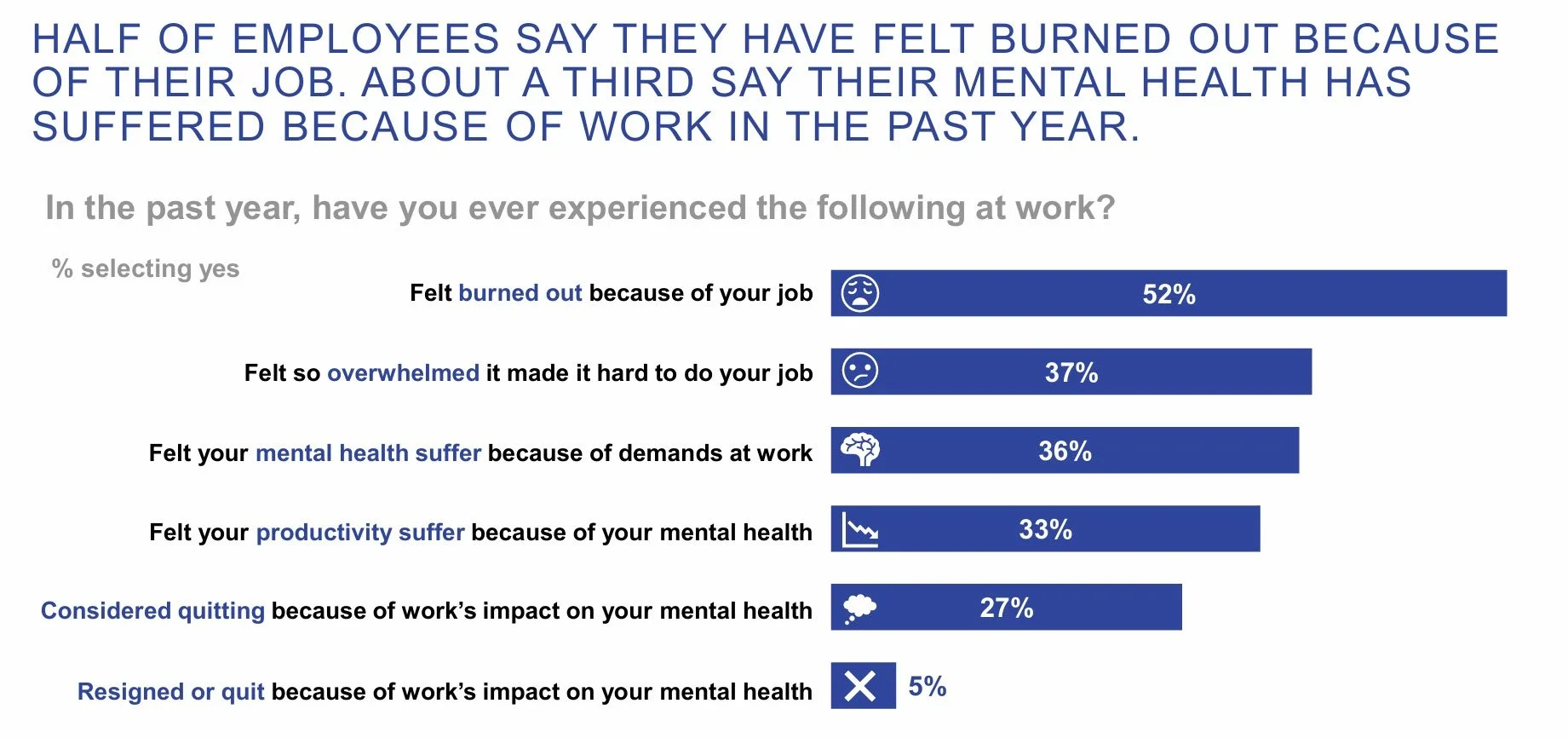Are Half of Your Leaders and Their Teams Burned Out?
If this year’s flurry of report findings is anything to go by, the answer might well be yes, depending on how well your organization focuses on well-being and supporting your employees.
Nearly half of U.S. middle managers are burning out on the job, according to LinkedIn’s 2024 Workforce Confidence survey, and the latest findings show this runs the risk of impacting their direct reports, too. About 30% of employees report having bosses who are often too stressed to support them at work.
Half of the world’s workers report stress on the job. And about 15% experience high stress on the job every day.
The Boston Consulting Group (BCG) reveals that, on average, 48% of workers from eight countries report currently grappling with burnout.
What Is Burnout?
Burnout is a state of physical, emotional, and mental exhaustion resulting from prolonged stress or overwork. It typically occurs when a person feels he/she has given so much energy and effort to something—such as work, caregiving, or personal responsibilities—that he/she can no longer sustain the usual levels of productivity and enthusiasm. Signs of burnout can include physical, emotional, cognitive, and behavioral symptoms.
“Burnout can be caused by stress, but it’s not the same. Stress results from too much mental and physical pressure and too many demands on your time and energy. Burnout is about too little. Too little emotion, motivation, or care. Stress can make you feel overwhelmed, but burnout makes you feel depleted and used up.”
Impact of Burnout on Team Dynamics
Burnout in leaders and their teams should be a cause for concern since it affects both individual well-being and the group's overall performance.
Communication Breakdown: Burnout in both leaders and team members can lead to poor communication. Leaders may not effectively communicate expectations, while team members may become reluctant to speak up or share concerns.
Trust Erosion: Leaders' lack of energy and engagement can erode trust. Team members may feel unsupported, and leaders may struggle to earn respect or confidence from their team.
Collaboration and Innovation Decline: A burned-out team often loses the motivation to collaborate creatively, leading to stagnation in problem-solving and idea generation.
Burnout develops over time, and while spotting it early can be difficult, organizations must address it before it leads to significant declines in productivity and/or morale. Here are some key questions to help identify burnout in leaders and their teams.
Identifying Burnout: 5 Workplace Behavior Changes in Leaders
1. Decreased Engagement, Productivity, and Effectiveness
Is a former strong leader showing a lack of enthusiasm or interest in his/her role, goals, or team success?
Is he/she less involved in meetings, decision-making, or initiatives, leading to a sense of disengagement?
Despite working long hours, has the quality of the leader’s work declined? For example, missed deadlines and projects that have lost momentum.
Has the leader expressed concern about putting in effort without seeing results? This can deepen his/her sense of frustration and burnout.
2. Increased Irritability or Cynicism
Has the leader become more short-tempered, easily frustrated, or sarcastic?
Does he/she exhibit a more negative outlook or frustration with the team's efforts, especially if he/she perceives no quick solutions?
Does he/she resent the demands of their job or the people they are leading, possibly projecting this frustration onto the team?
3. Difficulty Making Decisions
Does he/she struggle with decision-making and/or experience analysis paralysis or constantly second-guess him/herself?
Does the leader avoid making important choices or delay necessary actions, leading to stagnation?
4. Physical Symptoms
Does the leader show signs of fatigue, stress-related illness (headaches, stomach issues), or sleeplessness, which can affect their ability to lead effectively? These physical signs can be subtle but may be linked to burnout if they persist.
5. Behavioral Symptoms
Does the leader withdraw from social interactions or become more isolated, avoiding face-to-face meetings with his/her team or peers?
Is he/she no longer soliciting feedback or engaging in collaborative activities, causing a lack of connection with the team?
Identifying Burnout: 5 Signs to Look for in Teams
1. Declining Performance, Collaboration, and/or Productivity
Has there been a drop in team productivity, such as missed deadlines or lower-quality work? Are team members doing the minimum necessary to meet expectations?
Do team members report unmanageable workloads and excessive hours or responsibilities without adequate resources?
Has the team stopped collaborating effectively? Have members stopped offering help to each other, focusing only on their own tasks and avoiding teamwork? Has communication become strained?
Does the team appear to be more reactive than proactive? Do creative brainstorming and innovation sessions seem stifled? Is there a preference for "safe" or status-quo solutions rather than fresh ideas?
2. Low Morale and Motivation
Do team members seem disengaged? Do tasks that used to be completed efficiently take longer to finish?
Do team members appear disinterested or unmotivated? Is there a prevailing sense of apathy, with little enthusiasm for the work or upcoming projects?
When asked about their work, are responses short, filled with negativity, or lethargic?
3. Increased Absenteeism or Tardiness
Has the incidence of sick days, lateness, or unexplained absences increased?
Do team members show up physically but appear mentally "checked out," contributing little to team efforts?
4. Increased Conflict or Tension
Has team conflict increased? Burnout can cause frustration to bubble up, resulting in more disputes or misunderstandings within the team.
Team members may argue more frequently or exhibit passive-aggressive behavior, leading to a toxic work environment.
5. Physical and Emotional Symptoms
Are there signs of physical or emotional effects? Like leaders, team members may show physical signs of stress, such as fatigue, irritability, or frequent illness.
Burnout can also lead to emotional exhaustion, where team members feel "running on empty" and have nothing left to give.
“More than half (59%) of all employees are facing moderate or high burnout, with nearly a quarter (23%) facing high burnout. More than half (54%) of all employees are now confident that their employers care at least moderately about their mental health, with more than a quarter (28%) believing they care a great deal.”
Addressing burnout at work requires a mix of personal strategies and organizational support. Our next post in this series will explore strategies for organizations, leaders, and individual contributors to combat burnout and create a healthy, engaged, productive, and loyal workforce.
Reading & References
ARTICLES
“Burnout: Symptoms, Risk Factors, Prevention, Treatment.” WebMD. Your life feels meaningless, and you begin to neglect your health. Feeling empty. Exhaustion, anxiety, and panic set in. Despair. You may have feelings of self-hatred or depression coupled with suicidal thoughts. Total burnout.
REPORTS
“American Workforce Burnout Reaches Tipping Point.” Aflac Newsroom. The 14th Annual Aflac WorkForces Report uncovers very high levels of burnout - which is nearly twice as likely among U.S. Hispanic employees than non-Hispanics.
2024 Workforce State of Mind, Headspace. In its 6th annual workplace mental health report, Headspace surveyed employees, CEOs, and HR leaders to assess the latest trends in mental health at work.
Breedon, Jake. “The Silent Rhythm of Workplace Stress.” Psychology Today, Sussex Publishers, 19 Aug. 2024.
“Half of Workers around the World Are Struggling with Burnout.” BCG Global.
“NAMI/Ipsos StigmaFree Workplace Mental Health Survey.” NAMI, Jan. 2024.
Resources
“64 Workplace Burnout Statistics You Need to Know for 2024.”
“The 12 Stages of Burnout: Identification, Prevention & Treatment.” Providence Treatment, 22 Jan. 2020. Psychologists Herbert Freudenberger and Gail North developed the 12-stage model of burnout.
“The Workplace Stress Scale™” © 1978 The Marlin Company and The American Institute of Stress. Print this PDF and answer eight questions to calculate your stress score.





